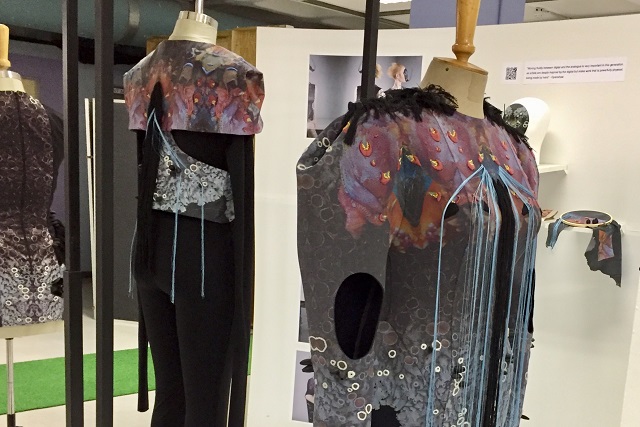14 Fashion students showcased their unique, futuristic designs at the BTech Fashion Exhibition held at the Durban University of Technology’s (DUT’s) Brickfield Campus. The students created designs for the exhibition which forms part of their annual practical component.
According to Farida Kadwa BTech co-ordinator for Fashion, a diverse range of topics were covered by the 2017 students. Janine Turner focused on a free-form knitted collection that embodies sustainable ideologies. “The collection consists of eight looks, and the designs were all created using 100% merino wool and 100% kid mohair. The collection also features modular garments which means that garment pieces fit together with modular attachments, enabling the wearer to put together their own designs.”
Balini Naidoo explored designing a braille identification system for clothing that will assist blind individuals in becoming more self-reliant and independent when making clothing choices. “Having a family member who is visually impaired has made me aware of the many struggles that are faced by the blind. According to the South African National Council for the Blind, the local communities in Durban, KwaZulu-Natal, and surrounding areas are faced with daily struggles in terms of self-imagery and making daily clothing choices.” Naidoo used an exploratory research approach led by the non-linear design thinking process focusing on five key stages of empathising, defining, ideating, prototyping and testing, in designing the braille identification system. She hopes her study will inspire more South African fashion designers and students to embrace the use of innovative designs for social responsibility in their practice.
Neshika Nundkwar looked at creating origami-based designs which are an interdisciplinary art form that deals with the ability to fold paper. “My study shows that origami can be applied in fashion, using different methods to create origami-based designs. Traditional pattern making techniques using existing origami paper folding approaches, were adapted to create garments.”
Jessica Shuttleworth explored digital printing of macro photographs onto textiles, and subsequently applied handcrafted surface design techniques such as embroidery and 3D digital printing to these textiles. “The practical component challenged me to overstep the boundaries of what I have ever done before; to practice, learn and build skills in every stage of experimentation. Collaboration with individuals from other design disciplines is encouraged when exploring methods of hybrid craft, as this will further enrich the skills base.”
The exhibition was open for viewing until 8 November 2017.
Pictured: Jessica Shuttleworth’s designs explore digital printing of macro photographs onto textiles.
Waheeda Peters/Carly van der Westhuizen


